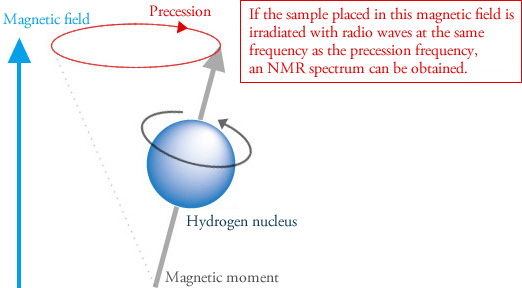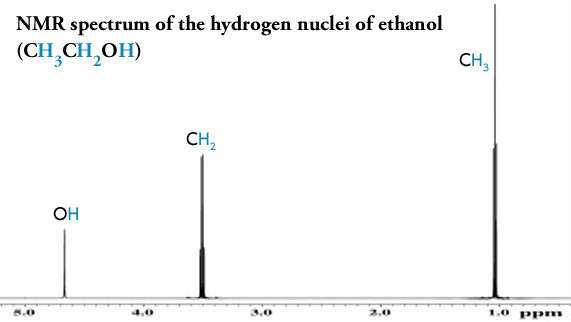The nuclei of many elements such as 1 H spin generating a magnetic field. Hornak is Professor of Chemistry and Imaging Science at the Rochester Institute of Technology where he teaches courses in magnetic resonance imaging nuclear magnetic resonance spectroscopy analytical chemistry and physical chemistry.

Nmr Basic Knowledge Nuclear Magnetic Resonance Spectrometer Nmr Products Jeol
The biomedical applications of nuclear magnetic resonance NMR are twofold.

. Apart from the molecular structure NMR spectroscopy can determine phase changes conformational and configurational alterations solubility and diffusion potential Krishnan 2019. Nuclear Magnetic Resonance Spectroscopy Tutorial 2 Nuclear magnetic resonance spectroscopy or nmr spectroscopy can be used to identify any isotope unless the isotope has both an even number of protons and an even number of neutrons. A powerful technique useful for.
Nuclear magnetic resonance NMR spectroscopy explores the electronic environment of atoms. Nuclear Magnetic Resonance Spectroscopy tutorial all along with the key concepts of Basic Principle of NMR The Source of NMR Spectra NMR spectrum Pattern of the Spectrum The NMR spectrometer Operational procedure Application of NMR. Nuclear magnetic resonance spectroscopy tutorial.
Nuclear magnetic resonance NMR is a spec- troscopic technique that detects the energy ab- sorbed by changes in the nuclear spin state. Carbon-13 has a nuclear spin I ½ and makes up 11 of all naturally occurring carbon a high enough abundance along with. The area under an NMR resonance is proportional to the number of nuclei that give rise to that resonance.
It is used to determine the molecular structure at the atomic level of a sample. Copyright 1997-2019 JP. Nuclear magnetic resonance NMR spectroscopy is a versatile tool that provides information on structures and dynamics of various biological and synthetic molecules at an atomic level.
Nuclear Magnetic Resonance Spectroscopy or NMR Spectroscopy can be used to identify any isotope unless the isotope has both an even number of protons and an even number of neutrons. Lecture 1 - Nuclear Spin and Magnetic Resonance Lecture 2 PDF - The Rotating Frame RF Pulses and the Bloch Equations Lecture 3 PDF - Magnetization Gradients k-space and Molecular Diffusion. The height of each step is proportional to the area under the resonance.
2 6 integral d 36 d 12 The relative area under the resonances at d 36 and 12 is 13 The integral is superimposed over the spectrum as a stair-step line. One is 12 which is anti-parallel to the magnetic field and the other is 12 which is parallel to the magnetic field. Wileyplus Nmr Spectroscopy And Nuclear Spin - An nmr spectrum is acquired by varying or sweeping the magnetic field over a small range while observing the rf signal from the sample.
Nuclear magnetic resonance spectroscopy NMR was first developed in 1946 by research groups at Stanford and MIT in the USA. Nuclear Magnetic Resonance NMR Spectroscopy is not limited to the study of protons. 1 H Nuclear Magnetic Resonance Spectroscopy Tutorial Key Concepts.
Any element with a nuclear spin 13 C 17 O 19 F 31 P and many others will give rise to an NMR signal. 13 C Nuclear Magnetic Resonance Spectroscopy Tutorial Key Concepts. Carbon Nuclear Magnetic Resonance 13C-NMR Spectroscopy.
No other technique has gained such significance as NMR spectroscopy. Nuclear Magnetic Resonance Spectroscopy or NMR Spectroscopy can be used to identify any isotope unless the isotope has both an even number of protons and an even number of neutrons. For the four common nuclei noted above the magnetic moments are.
Nuclear magnetic resonance NMR spectroscopy is an advanced characterization technique. Nuclear Magnetic Resonance NMR Spectroscopy. E2 12 γh 2Π H0.
These moments are in nuclear magnetons which are 50507810-27 JT-1. The applications of MRS as a research tool are extremely diverse encompassing studies on isolated cells body fluids and perfused organs at high magnetic field strengths in an experimental. 13 c nuclear magnetic resonance spectroscopy tutorial key concepts.
1H NMR is used to determine the type and number of H atoms. H0 is magnetic field which separates the energy into two. Mass spectrometry MS is an analytical technique that is used to measure the mass-to-charge ratio of ionsThe results are presented as a mass spectrum a plot of intensity as a function of the mass-to-charge ratioMass spectrometry is used in many different fields and is applied to pure samples as well as complex mixtures.
Nuclei with an odd mass or odd atomic number have nuclear spin in a similar fashion to the spin of electrons. A powerful technique useful for identifying the small to the very large When some atoms are placed in a strong magnetic field their nuclei behave. NMR Spectroscopy - NMR Nuclear Magnetic Resonance - An nmr spectrum is acquired by varying the magnetic field over a small range while observing the rf signal from the sample.
The nuclei of many elements such as 13 C spin generating a magnetic field. There are two major relaxation processes. The SCSB NMR Laboratory is located in its own two-story.
With the newly developed hardware physicists and chemists began to apply the. The following diagram gives the approximate frequencies that correspond to the spin state energy separations for each of these nuclei in an external magnetic field of 235 T. 1 H μ 27927 19 F μ 26273 31 P μ 11305 13 C μ 07022.
Magnetic resonance imaging MRI and magnetic resonance spectroscopy MRS. The radar technology developed during World War II made many of the electronic aspects of the NMR spectrometer possible. Two common types of NMR spectroscopy are used to characterize organic structure.
Nuclear Magnetic Resonance Spectroscopy. The application of NMR spectroscopy to the study of proteins and nucleic acids has provided unique in- formation on the dynamics and chemical kinetics of these systems. Nuclear magnetic resonance spectroscopy is a powerful analytical technique used to characterize organic molecules by identifying carbon-hydrogen frameworks within molecules.
Nuclear magnetic resonance NMR spectroscopy measurements have been firmly established among techniques used for obtaining valuable information about chemical and physical properties in a wide variety of scientific fields from biology and medicine to chemistry and physics. Nuclear Magnetic Resonance Spectroscopy Tutorial.

Nmr Basic Knowledge Nuclear Magnetic Resonance Spectrometer Nmr Products Jeol

Basic Introduction To Nmr Spectroscopy Youtube

Nmr Spectroscopy In Easy Way Part 1 Youtube

Nuclear Magnetic Resonance Nmr Youtube


0 komentar
Posting Komentar